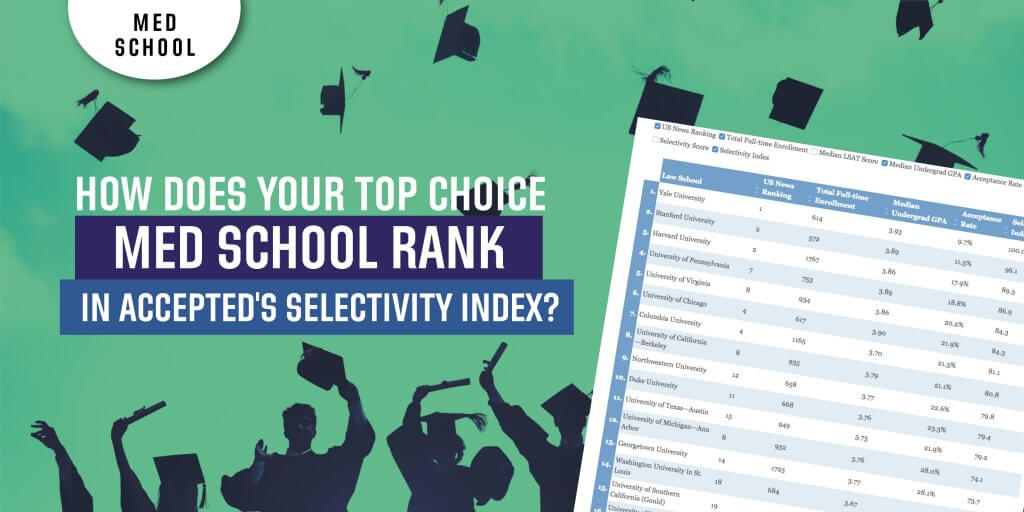
The highest, hardest, and lowest in the Med School Selectivity Index:
• The Mayo Clinic is the hardest medical school to get into. It combines the lowest acceptance rate with highest median MCAT and GPA. It is closely followed by Harvard and Stanford.
• The Mayo Clinic has the lowest acceptance rate of any medical school followed by Stanford and – here’s a surprise – Wake Forest.
• NYU Langone, Vanderbilt, Yale, and Washington University in St. Louis have the highest median MCAT. All tied at a stratospheric 521.
• Johns Hopkins has the highest average GPA (3.94) for accepted medical students. NYU Langone and Harvard are in the #2 and #3 spots on this one.
• 11 med schools have a median undergrad GPA for accepted students of 3.9+.
• The Mayo Clinic has the lowest acceptance rate of any medical school followed by Stanford and – here’s a surprise – Wake Forest.
• NYU Langone, Vanderbilt, Yale, and Washington University in St. Louis have the highest median MCAT. All tied at a stratospheric 521.
• Johns Hopkins has the highest average GPA (3.94) for accepted medical students. NYU Langone and Harvard are in the #2 and #3 spots on this one.
• 11 med schools have a median undergrad GPA for accepted students of 3.9+.
While it’s interesting to see the schools with highest stats or the most selective programs, don’t forget to look at the numbers that are in the same range as your stats for guidance on where to apply to medical school. This data can help you apply thoughtfully, purposefully, and successfully.
Med School Applications are Expensive!
Between primary and secondary application fees, you will spend hundreds of dollars just to apply through AMCAS. If you apply to 20 programs you face approximately $3000 in primary & secondary application fees alone. The cost of applying to medical schools is slightly higher when applying through AACOMAS.
You want to maximize your chances of acceptance and make the most of the financial investment required by the application process. You need to apply mostly to schools that will consider your application seriously. Otherwise, you’re wasting your time and money. Yes, you can apply to one or two dream schools, but for most of your applications, you need to apply realistically.
What about Holistic Admissions to Medical School?
You may be thinking: Isn’t the medical school admissions process holistic? Why all the focus on GPA and MCAT?
You’re right. Medical school admission is not exclusively about your GPA and MCAT score. Schools also evaluate important qualitative aspects of your profile: community service, clinical exposure, research, leadership, shared values, personal background, and goals. Furthermore the stats can’t reveal the impact of the schools’ attempts to diversity the physician-in-training pipeline given your background. The Selectivity Index doesn’t reflect the impact of those qualitative factors, but it doesn’t provide you with usable data that you need to weigh as you apply.
Those average GPA and MCAT numbers don’t happen by accident. They are not random. Schools are purposeful in selecting whom to interview and admit. And the MCAT score and GPA play a role.
What About In-State and Out-of State Differences?
Good question. The acceptance rates in the Selectivity Index give the overall acceptance rate and do not reflect what can be whopping differences between in-state and out-of-state acceptance rates. For example, the University of Washington has a 21.2% in-state acceptance rate, but only a 0.6% out-of-state acceptance rate. If you are not a resident of Washington or one of the states with which it has a reciprocity agreement, you should think twice about investing in an application to UW. In contrast, Washington University of St. Louis, a private university, accepts 8.9% of in-state applicants and 10.6% of out-of-state residents. However, its median MCAT is 521 and its median GPA is 3.91. It may be more welcoming to out-of-state applicants, but it clearly weighs the stats. (Data from MSAR and U.S. News)
We have compiled a table showing in-state and out-of state medical school acceptance rates for the schools in MSAR. Check out that data before you apply. Again, maximizing your chances of acceptance is the goal here.
You definitely should be aware of these differences when you apply. They are critical to a strategic approach to medical school applications.
Learn How an Admissions Consultant Can Help You Get into Medical School
The medical school application process is emotionally and financially draining, and competition is fierce. The acceptance rate for many med schools is under 10%, with an overall acceptance rate for all MD and DO programs of well under 50%. If you want to do it once (or only once more if you are a reapplicant), you need to be thoughtful, strategic, and purposeful when you choose where to apply.
And an admissions consultant can help dramatically.
When you work one-on-one with an expert (and objective) admissions advisor, one with decades of experience guiding applicants just like you to acceptance at top medical schools, you position yourself for success. Explore our Medical School Admissions Consulting services, choose the best med programs to apply to, and then submit a stellar app that will get you ACCEPTED.
And don’t forget to include the Med School Selectivity Index as one tool in your toolkit as you make your decisions.
Related Resources:
• Navigate the Med School Application Maze, a free guide
• How To Research Medical Schools
• Choosing the Best Medical Schools for YOU
This article was originally posted on blog.accepted.com.• How To Research Medical Schools
• Choosing the Best Medical Schools for YOU
Applying to medical school? The talented folks at Accepted have helped hundreds of applicants like you get accepted to their dream programs. Whether you are figuring out where apply, working on your AMCAS application, working on secondary essays, or prepping for your interviews, we are just a call (or click) away. Contact us, and get matched up with the consultant who will help you get accepted!
